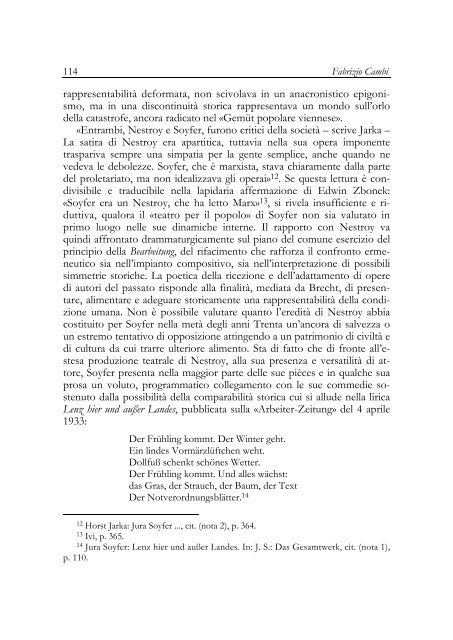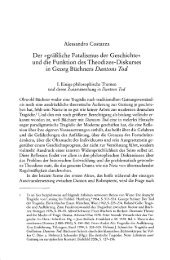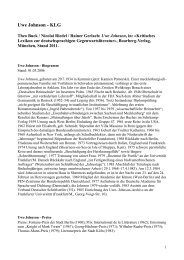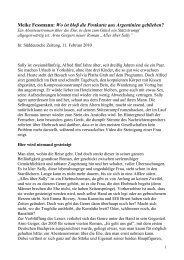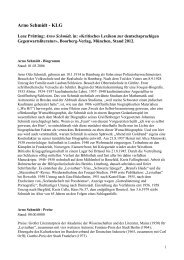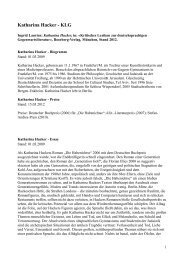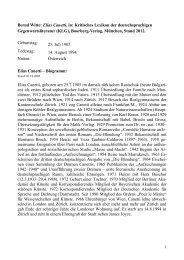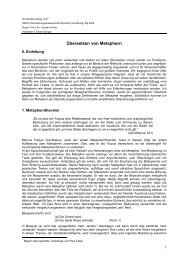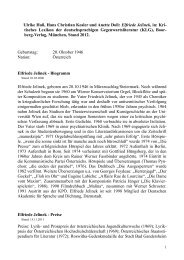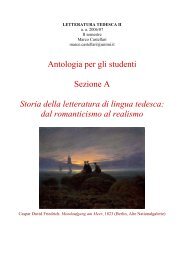Johann Nepomuk Nestroy Tradizione e trasgressione a cura di ...
Johann Nepomuk Nestroy Tradizione e trasgressione a cura di ...
Johann Nepomuk Nestroy Tradizione e trasgressione a cura di ...
Erfolgreiche ePaper selbst erstellen
Machen Sie aus Ihren PDF Publikationen ein blätterbares Flipbook mit unserer einzigartigen Google optimierten e-Paper Software.
114<br />
Fabrizio Cambi<br />
rappresentabilità deformata, non scivolava in un anacronistico epigonismo,<br />
ma in una <strong>di</strong>scontinuità storica rappresentava un mondo sull’orlo<br />
della catastrofe, ancora ra<strong>di</strong>cato nel «Gemüt popolare viennese».<br />
«Entrambi, <strong>Nestroy</strong> e Soyfer, furono critici della società – scrive Jarka –<br />
La satira <strong>di</strong> <strong>Nestroy</strong> era apartitica, tuttavia nella sua opera imponente<br />
traspariva sempre una simpatia per la gente semplice, anche quando ne<br />
vedeva le debolezze. Soyfer, che è marxista, stava chiaramente dalla parte<br />
del proletariato, ma non idealizzava gli operai» 12 . Se questa lettura è con<strong>di</strong>visibile<br />
e traducibile nella lapidaria affermazione <strong>di</strong> Edwin Zbonek:<br />
«Soyfer era un <strong>Nestroy</strong>, che ha letto Marx» 13 , si rivela insufficiente e riduttiva,<br />
qualora il «teatro per il popolo» <strong>di</strong> Soyfer non sia valutato in<br />
primo luogo nelle sue <strong>di</strong>namiche interne. Il rapporto con <strong>Nestroy</strong> va<br />
quin<strong>di</strong> affrontato drammaturgicamente sul piano del comune esercizio del<br />
principio della Bearbeitung, del rifacimento che rafforza il confronto ermeneutico<br />
sia nell’impianto compositivo, sia nell’interpretazione <strong>di</strong> possibili<br />
simmetrie storiche. La poetica della ricezione e dell’adattamento <strong>di</strong> opere<br />
<strong>di</strong> autori del passato risponde alla finalità, me<strong>di</strong>ata da Brecht, <strong>di</strong> presentare,<br />
alimentare e adeguare storicamente una rappresentabilità della con<strong>di</strong>zione<br />
umana. Non è possibile valutare quanto l’ere<strong>di</strong>tà <strong>di</strong> <strong>Nestroy</strong> abbia<br />
costituito per Soyfer nella metà degli anni Trenta un’ancora <strong>di</strong> salvezza o<br />
un estremo tentativo <strong>di</strong> opposizione attingendo a un patrimonio <strong>di</strong> civiltà e<br />
<strong>di</strong> cultura da cui trarre ulteriore alimento. Sta <strong>di</strong> fatto che <strong>di</strong> fronte all’estesa<br />
produzione teatrale <strong>di</strong> <strong>Nestroy</strong>, alla sua presenza e versatilità <strong>di</strong> attore,<br />
Soyfer presenta nella maggior parte delle sue pièces e in qualche sua<br />
prosa un voluto, programmatico collegamento con le sue comme<strong>di</strong>e sostenuto<br />
dalla possibilità della comparabilità storica cui si allude nella lirica<br />
Lenz hier und außer Landes, pubblicata sulla «Arbeiter-Zeitung» del 4 aprile<br />
1933:<br />
Der Frühling kommt. Der Winter geht.<br />
Ein lindes Vormärzlüftchen weht.<br />
Dollfuß schenkt schönes Wetter.<br />
Der Frühling kommt. Und alles wächst:<br />
das Gras, der Strauch, der Baum, der Text<br />
Der Notverordnungsblätter. 14<br />
12 Horst Jarka: Jura Soyfer ..., cit. (nota 2), p. 364.<br />
13 Ivi, p. 365.<br />
14 Jura Soyfer: Lenz hier und außer Landes. In: J. S.: Das Gesamtwerk, cit. (nota 1),<br />
p. 110.


